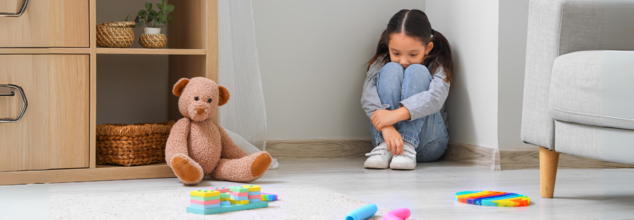- Health Conditions A-Z
- Health & Wellness
- Nutrition
- Fitness
- Health News
- Ayurveda
- Videos
- Medicine A-Z
- Parenting
- Web Stories
World Health Day: Is Your Child’s Behavior Just A Phase? Expert Reveals Signs Of Mental Health Struggles In Kids

Image Credits: Canva
It's a question that quietly lingers in many parents' and caregivers' minds perhaps your normally cheerful child has been unusually quiet. Or maybe your teenager, once outgoing and lively, appears more withdrawn or irritable by the day. You attribute it to growing pains, hormones, or school stress. But deep in your belly, a small voice whispers: Could this be something more ominous?
Maybe at last mental health is finally receiving the attention it should receive. And yet with children, it's still simple to miss the early warning signs. After all, kids don't always know how they're feeling—and sometimes their distress manifests itself in seemingly random ways, like difficulty sleeping, tantrums, or even reports of a tummy ache.
In the complex process of childhood development, mental health tends to take a backseat to worry about physical growth, vaccinations, and diet. But as there is growing awareness about emotional health worldwide, it's increasingly becoming apparent that children's mental health deserves as much concern and care as their physical health. In fact, pediatricians are now leading the way in detecting early warning signs that could indicate more serious psychological problems.
We interviewed Dr. Kushal Agrawal, Department Head of Neonatology and Paediatrics, to learn how pediatricians recognize the early warning signs of mental health issues—and why parents must never second-guess their instincts. His observations shed light on what's normal, what's not, and how early intervention can be the difference-maker in a child's life.
In keeping with the World Health Organization's findings, it is estimated that one in every six children in the 10-19 year age group suffer from a mental health condition. Experts point out that early detection and intervention are what can transform a child's life. Dr. Kushal, points out, "Being pediatricians, we are also the first stop when children exhibit slight changes in mood or behavior. While overall physical health still takes precedence, the increasing rates of mental disorders in children deserve equal priority.
What Mental Health in Children Really Means?
Child mental health is the emotional, psychological, and social well-being that determines how they think, feel, and behave. It is instrumental in enabling them to deal with stress, relate to others, and make proper choices. While physical illnesses are more apparent and can be diagnosed easily, mental health issues tend to present themselves subtly—sometimes not being noticed until they start impacting schoolwork, social interaction, or family dynamics.
A child's mental health is not fixed but changes with age, environmental factors, and biological growth. Hence, it is important to have constant interaction and monitoring in identifying red flags early.
Common Mental Health Disorders Identified in Children
Children may exhibit a range of mental health disorders that appear during different phases of their lives. These include developmental and mood as well as behavioral disorders:
Autism Spectrum Disorder (ASD): Marked by communication problems and repetitive activities, symptoms typically emerge in early childhood and greatly differ in intensity.
Attention-Deficit/Hyperactivity Disorder (ADHD): ADHD is a very frequent neurodevelopmental disorder among children, commonly associated with inattention, impulsiveness, and restlessness.
Post-Traumatic Stress Disorder (PTSD): This disorder might occur after the experience or witness of a traumatic event. PTSD children tend to have difficulty with flashbacks, sleep disturbances, and emotional unresponsiveness.
Obsessive-Compulsive Disorder (OCD): Children who have OCD have uncontrollable, repetitive thoughts and acts they feel the need to repeat.
Mood Disorders: Both depression and bipolar disorder may be seen in children, usually disguised as irritability or hostility.
Developmental Disorders: These are a range of disorders involving language, behavior, and learning disorders, and usually require early treatment.
Dr. Agrawal explains, "Mental health issues may manifest differently in children than in adults. One of the first signs is a clear change in behavior—avoidance of activities they previously enjoyed, sudden belligerence, or persistent unhappiness."
Early Warning Signs Parents Shouldn't Ignore
Getting ahead of the game starts with paying attention. Kids might not have the words or emotional maturity to describe their suffering, so their pain tends to emerge through behavior.
Behavioral Changes: Sudden moodiness, chronic irritability, or defiance can be more than a bad day. A reclusive extroverted child, or an aggressive child previously mild, warrants closer scrutiny.
Sleep and Eating Changes: Sleep disruptions—insomnia, nightmares, or hyper-sleeping—and shifts in appetite are potential precursors of emotional stress or anxiety.
Academic Struggles: A former high-achieving student might suddenly turn away from homework, face difficulty maintaining attention, or act out in class. "Decline academically is another significant signal," responds Dr. Agrawal. "A declining, previously attentive student may be quietly fighting anxiety or depression."
Physical Complaints: Persistent, unexplained headaches or stomachaches—particularly coupled with stress-producing situations—are commonly associated with emotional pain.
Regressive or Risky Behaviors: Young children can regress to previous behaviors like bedwetting or clinginess, whereas older children can indulge in risky behavior or show hopelessness.
Supporting Mental Health at Home
The home environment is a critical factor in a child's mental and emotional health. Dr. Agrawal believes in empowering parents with practical strategies that assist in creating a stable, supportive environment.
Establish Open Communication
Create a space where your child feels safe discussing emotions. Avoid rushing to solutions—instead, listen actively and validate their feelings. This reassures them that they are not alone.
Maintain Routine and Predictability
Children find comfort in structure. Regular mealtimes, bedtime routines, and household rules provide a sense of security, especially during stressful times.
Encourage Healthy Lifestyle Habits
Exercise, healthy eating, and sleep have a significant effect on mood and mental focus. Everyday family activities such as evening strolls or family meals can reinforce connections and enhance emotional well-being.
Educate Yourself and Your Child
Learning about mental health dispels the stigma. With child-friendly materials, tell your child that mental health is as vital as physical health—and that asking for help is a strength.
Use Positive Reinforcement
Accepting your child's efforts and accomplishments, however minor, increases their self-esteem and resilience. Praise effort, not perfection.
When to Seek Professional Help?
Dr. Agrawal suggests that parents "trust their instincts—if something feels 'off,' it probably is." Regular pediatric check-ups are a good time to mention concerns. Pediatricians can offer initial evaluation and refer families to child psychologists or psychiatrists, as needed.
It's crucial not to wait to seek professional help. Early intervention can lessen the severity of mental illness and provide children with coping skills that last a lifetime.
Identifying and treating children's mental health is not just a parent's job—it takes a shared effort from educators, caregivers, and healthcare providers. As awareness increases in society, so must our dedication to listening, watching, and acting early.
Dr Kushal Agrawal is HOD, Department of Neonatology and Paediatrics at KVR Hospital, Kashipur in India.
Kiara Advani And Sidharth Malhotra Welcome Their First Baby: This Is What Lies Ahead Of New Parenthood

Kiara Advani and Sidharth Malhotra have become parents. They are blessed with their first child, a baby girl on July 15. Both the actors shared a joint statement, "Our hearts are full, and our world forever changed. We are blessed with a baby girl. Kiara & Sidharth."

As the couple welcomes their baby and get used to the new life, a lot more is to come for both. While parenthood is a blessing, it is also challenging. Welcoming a baby also means a period of postpartum for the mother. So, how does it all work out? How can mothers smoothly sway through this phase?
What Happens In Postpartum Phase?
Postpartum brings a cascade of physical, emotional, and hormonal changes that deeply affect new mothers. “There are uterine changes, which means the uterus expands during the pregnancy and begins to shrink back to its pre-pregnancy size after childbirth. This may cause cramping,” explains Dr Sushma Pampanavar, gynecologist and obstetrician.
She adds, “Hormonal shifts, especially estrogen and progesterone drop rapidly after delivery, this can affect the mood.” Dr Pampanavar also points out that postpartum symptoms include “postpartum bleeding and discharge, also known as lochia, which goes on for a few weeks.”
Other physical changes involve engorged breasts, nipple sensitivity, and pelvic floor discomfort which can lead to urinary incontinence. “Your body goes through so many changes all at once,” she says, highlighting the layered transition women undergo physically and emotionally.
Dr Himanshu Nirvan, psychiatrist, elaborates on the emotional toll, stating that “persistent feelings of sadness, hopelessness and irritability in mothers can lead to difficult bonding with the baby and thoughts of harming oneself or the baby.”
He warns that if left unaddressed, postpartum can “potentially strain the mother-child relationship, leading to feelings of detachment, neglect or irritability.” To support healing, he recommends, “Joining new parent groups, seeking online forums, attending support groups, and connecting with other mothers.”
Speaking about postpartum after pregnancy loss, Dr Avir Sarkar, gynecologist and assistant professor, says, “Experiencing a pregnancy loss, whether through surgical abortion or delivering a stillborn baby due to miscarriage, can indeed lead to a complex and emotional postpartum experience for women.”
He adds, “Women still experience bleeding, hormonal shifts and other postpartum symptoms, along with the profound emotional impact of pregnancy loss,” and suggests, “Allow yourself to grieve, express your emotions and seek support from loved ones and healthcare providers.”
What Can Help You Heal?
In a world that glorifies productivity, “doing nothing” as a new mother sounds almost rebellious. Yet, for many postpartum women, embracing rest over relentless activity might be the most healing thing they can do. After childbirth, while the spotlight shines on the baby, the mother is often left to quietly cope with bleeding, sleep deprivation, hormonal shifts, and emotional upheaval—all while being told to “bounce back.”
Cultural images of polished, picture-perfect new moms—like public figures stepping out in heels and makeup just hours after delivery—set dangerously unrealistic standards. But the truth is, the body takes time to heal. The uterus alone takes around six weeks to return to its pre-pregnancy size, and emotional recovery can take even longer. That’s why the idea of “doing nothing” in postpartum isn’t about laziness; it’s about reclaiming space to rest, bond, and recover.
Doing nothing may look like holding your baby while binge-watching TV, letting go of expectations around housework, or allowing cereal to be dinner more nights than not. It might involve skipping extra chores, saying no to guests, and prioritizing sleep whenever possible.
For multitasking moms especially, embracing this mindset can be tough. But those who slow down often find clarity and peace. As the article notes, pushing yourself too soon can lead to physical complications and emotional burnout, while accepting a slower pace can help you emerge stronger and more present.
Is It Safe To Let Teens Drive? Study Finds Teens Spend A Fifth Of Their Time Driving, On The Phone

(Credit-Canva)
Learning how to drive is a big step of independence for children. It marks a phase where they learn responsibility, how to manage the autonomy they have gained as well as their way around different situations. There are many dangers associated with driving, hence there is a level of trust a parent must have before they let their teens drive. Whether it is others driving recklessly, difficult roads to travel in or themselves being careless. As teens are very well known for their lack of well-thought out actions, many of them find using their phones while driving normal.
A new study reveals a concerning trend: about one-fifth of the time, teenage drivers are looking at their smartphones instead of the road. This means they're not paying attention to what's in front of them or checking their mirrors.
The study, published in the journal Traffic Injury Prevention, found that teen drivers spend an average of 21% of each trip focused on their phone. What's more, these weren't just quick peeks. Nearly 27% of the time, drivers were looking at their phones for two seconds or longer. This amount of time dramatically increases the chance of a car crash.
Why Teens Use Their Phones Behind the Wheel
So, what are teens doing on their phones while driving? The study showed:
- Entertainment (like social media or videos) was the top reason, accounting for 65% of phone use.
- Texting came in second at 40%.
- About 30% of teens used their phone's GPS for navigation.
The Dangers of Distracted Driving
Distracted driving is a serious threat to public safety, especially among young drivers. When someone drives while distracted, they're not just putting themselves at risk of injury or death; they're endangering everyone else on the road.
While 35 U.S. states have laws banning all phone use for young drivers, a previous national study found that nearly 92% of teens still regularly use their smartphones for texting, talking, or playing music while driving.
What Teens Understand (and What They Don't)
For this new study, researchers asked over 1,100 teenagers about their habits and beliefs regarding smartphone use while driving.
Many young drivers actually understand that bad things can happen when they're distracted. They also know that their parents and friends wouldn't want them using their phones while driving. Teens also strongly believe they can avoid distracted driving by using features like "Do Not Disturb," hands-free modes, or phone holders. They recognize the benefits of using phone features like GPS but also understand the higher risk of accidents when distracted.
However, teens also said that their friends often drive while distracted by their phones. This suggests that more teens might be giving in to the temptation than they're willing to admit.
How to Encourage Safer Driving
Researchers suggest creating messages that challenge false beliefs about using phones while driving, such as the idea that you can still be productive on your phone while in transit. To help reduce this dangerous behavior, they recommend:
- Encouraging the use of "Do Not Disturb" mode on phones.
- Keeping phones out of reach while driving.
- Making sure teens get enough sleep, as tiredness can also increase distraction.
3 Medical Emergencies Schools Should Be Prepared For - Biggest Concerns For Paramedic Responses

(Credit-Canva)
Accidents can happen anytime and anywhere. Even if it is at school or at any other trust place. Health crisis may not seem like a big concern for school going children, however, understanding how unpredictable injuries and health concerns can be, it is important that emergency services are always ready. Many times, during these situations, a quick response is crucial, losing even moments could make or break the crisis.
However, what are the most likely health situations that can arise and how much should a school be worried about? New research reveals that U.S. schools should prioritize preparedness for three common health emergencies: brain-related crises, psychiatric/substance abuse issues, and trauma-related injuries. These three categories collectively account for approximately half of all emergency medical services (EMS) responses to schools.
Key Findings from the Study
A report published in the journal Pediatrics analyzed over 506,500 EMS calls to schools between 2018 and 2022, focusing on children aged 5 to 17. The study identified the following breakdown of emergency types:
- Neurologic problems (e.g., seizures): 19% of EMS calls.
- Psychiatric conditions or substance abuse: Nearly 17% of calls.
- Accidental injuries: Another 15% of calls.
The study also noted differences across age groups: elementary school students were more likely to require treatment for physical injuries (17%), while teenagers more frequently needed help for psychiatric conditions or substance abuse (18%).
Enhancing School Preparedness
Researchers emphasized the need for schools to enhance their emergency preparedness. He highlighted that timely treatment is crucial and suggested specific areas for staff training. According to US School Safety guidelines planning for emergencies must involve actions and daily routines that help create a secure school environment. These efforts can stop bad things from happening or lessen their impact if they do. Good planning also helps schools find and fix any weaknesses in their procedures and helps school staff and local emergency teams understand and handle their duties.
Creating a School Emergency Plan
A key part of emergency planning is putting together a complete school emergency operations plan (EOP). This is a document that explains what students, teachers, and school staff should do before, during, and after an emergency.
Developing this plan should be a team effort. It needs a diverse group of people from the school, as well as local community partners. Schools should also plan to check, evaluate, and update their EOP regularly to keep it current and effective.
Doing training, exercises, and drills that are right for different age groups can also help schools get ready for emergencies. These activities help everyone in the school community know their roles before, during, and after an emergency. They also give people a chance to practice the steps outlined in the EOP and improve how prepared they are.
Exercises and drills should be customized to fit the specific school community, including students' ages and physical abilities. It's also important to balance these drills with the school's overall culture and atmosphere.
Planning for Recovery After an Incident
Schools and districts can also plan for how they'll recover from emergencies even before they happen. This can make the recovery process quicker and more effective. As part of this, school emergency management teams should have a general strategy and plan to help the school community recover academically, physically, emotionally, and financially after an emergency.
© 2024 Bennett, Coleman & Company Limited

